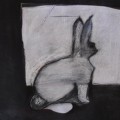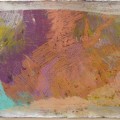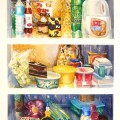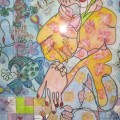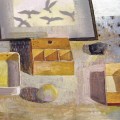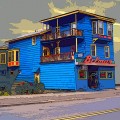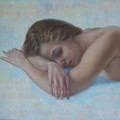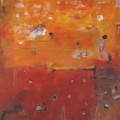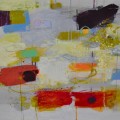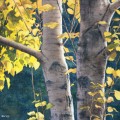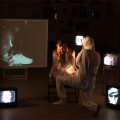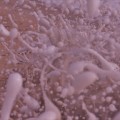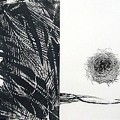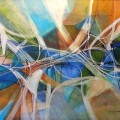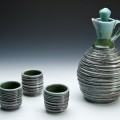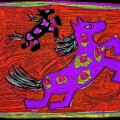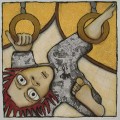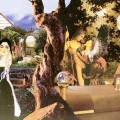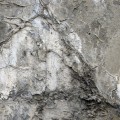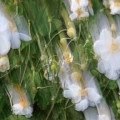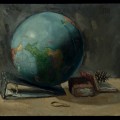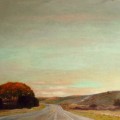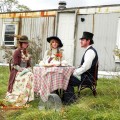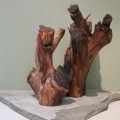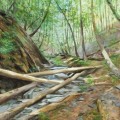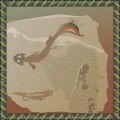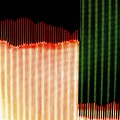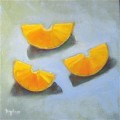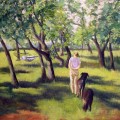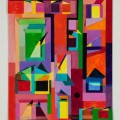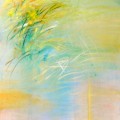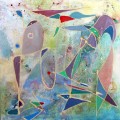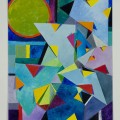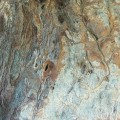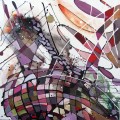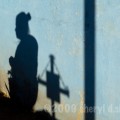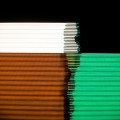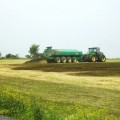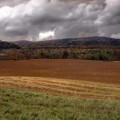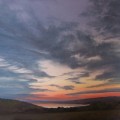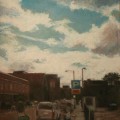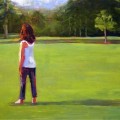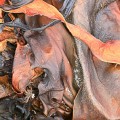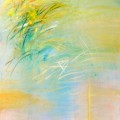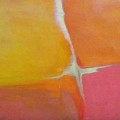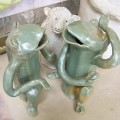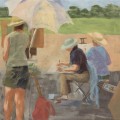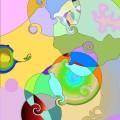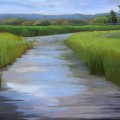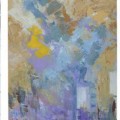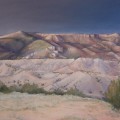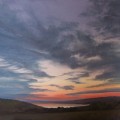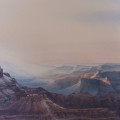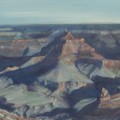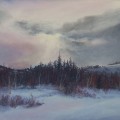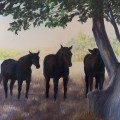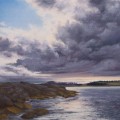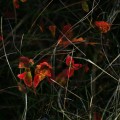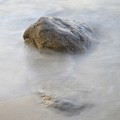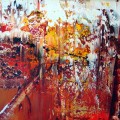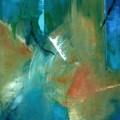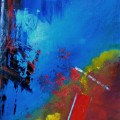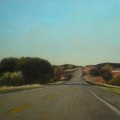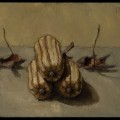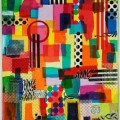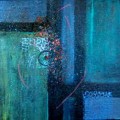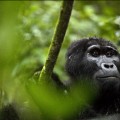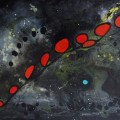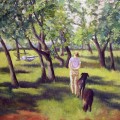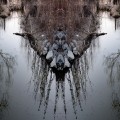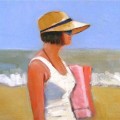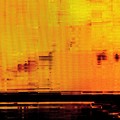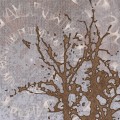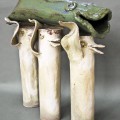Steven Skopik
Associate Dean for Faculty
Department of Cinema, Photography and Media Arts
Ithaca College
When I visited the gallery to look at the Sate of the Art gallery’s current photography exhibition, I was immediately taken with the scope of the work on the walls. Photographs are endlessly compelling because they have so many cultural uses—informational (in the cases of documentary and journalism), rhetorical (to the extent that some photos assert opinions and conduct implicit or overt arguments), and aesthetic (since yet other photographs explore more aesthetic avenues of expression). Along those lines, bestowing a “best of the show” award—or a first, second, and third prize–presents a daunting challenge. To indulge the cliché, selecting a wining image (or images) would be to compare apples and oranges, and would likely have as much to do with telegraphing the idiosyncratic tastes of the juror, as reflecting the intrinsic worth of the work. Thus, I’ve elected to honor equally five images that for me stand as particularly successful exemplars of their type, affirming the fascinating variety of approaches to photography seen in the exhibition.
In no hierarchical order, then, other than the convenience of taking you through the gallery from front to back, I’d begin with Kristina Heisey’s image titled “Abrosia.” Ms. Heisey’s picture is striking on a number of levels. Certainly the picture is visually arresting. With its super-saturated, nearly neon-bright swirl of color, the photograph provides a can’t-miss-it-from-across-the room, amped-up visual punch. I’m often fond of employing food analogies in the discussion of visual work–perhaps appropriate, given the piece’s title. If this whirling blob of plasma had a texture and taste, I imagine it would possess the chewy tang of Starbursts candy. (For those who haven’t had the pleasure, imagine saltwater taffy infused with a sour fruitiness whose intensity owes less to flavors found in nature than some diabolical lab experiment–wholly invented, but intensely pleasurable.)
Lurking below the playful allure of Ms. Heisey’s image is an interestingly confounding problem. The picture is almost completely abstract. So distorted or transformed is the physical object or process pictured, that at least on first consideration, it could just as easily have been painted, or executed as a computer drawing–rendered in a painting program of one sort or another. In this sense, the piece asks some rather basic questions. What is this thing? Is it even a photograph at all? Does the answer really matter?
For me, the easy-to-overlook detail that nudges the image into the realm of the photographic is the discovery that the picture rewards very close inspection. Like a conventional photograph that offers up greater and greater detail the more minutely one inspects it (this is arguably one of the medium’s most essential attributes), beyond an initial encounter with the image’s loud colors and emphatic motion effects, close scrutiny of “Ambrosia” reveals minute and subtle details. For example, one sees an intricate, thread-like moiré effect, hints of order and structure. The piece is, then, is something of an “anti-photographic” photograph.
A piece that similarly employs photography towards conceptual ends is Randi Millman Brown’s “Deaccessioned.” To deaccession is to remove an artwork from a museum’s collection. The term has a specific meaning in a professional context, but it also summons up associations of faded value, obsolescence, and abandonment. When I hear the term deaccession, I can’t help but think of rusted-out, discarded naval vessels. Deaccessioned. Decomissioned. Gone. Kaput. Over.
Milman’s diptych reproduces a grid of slides of well-known paintings. A moment’s consideration suggests that it cannot be the actual canonical works that are to be taken out of commission. Rather it is the film-based slides themselves that are likely being discarded. Thus, the piece stands as something of an elegy for the passing of a certain kind of image making—the photograph in its tangible, analog incarnation.
A lot has been written regarding the photograph’s resonance with mortality and the transitory. After all, any photograph presents a vivid description of something (or someone) that is irretrievably remote in both space and time. The piece “Deassession” is, I think, a kind of double lament. It can’t help but acknowledge the photograph’s characteristic commerce with time, memory, and ephemerality, and it extends that sense of loss to a consideration of the medium itself.
In Susan Larkin’s “Monkshood” we see in an image whose allure is less cerebral than it is frankly sensual. Evoking the early twentieth century German photographer Albert Renger-Patchz, who similarly trained his camera on a range of different types of plants, usually withered and pictured against a blank background, Ms. Larkin’s picture meticulously describes her subject in a manner that grants it a delicious availability.
In contrast to Kristina Heisey’s image, which as mentioned tends to refute it’s own status as a camera-made picture, the appeal of Larkin’s piece is rooted in a quintessentially photographic effect. The photograph, more than any other type of representation, is able to offer forth its subject with a strange, urgent sense of “therenesss.” Larkin achieves this odd hyper-present effect through the use of razor-sharp focus, and her photo’s richly detailed tonal description of the withered stalks and pods. The plants have an astonishing luminous quality; they appear to radiate light, rather than reflect it. The net effect is to imbue these modest objects with an unaccountable sense of poised significance.
Finally, it must be said, that despite their husk-like state of desiccation, the plants possesses a vivid sensuality. No doubt this is in part due to the picture’s formal attributes (just described), but it also has to do with the subject matter, which summons up associations with life, death, and reproduction and renewal. I’m not familiar with this particular species, but I assume we’re looking at seed vessels of some sort. To declare that this is an erotic photograph is merely to state the facts; Larkin allows us to look lingeringly on the genitals and reproductive apparatus of a living–or once living– organism. Intended in an entirely complementary manner, this image is the exhibition’s most overtly lurid photograph.
Moving on to Myron Walter’s “Genoa Feed Mill” we see an image whose expressive register is less purely descriptive than it is poetic. On first consideration, one cannot think of a less promising occasion for aesthetic of contemplation. The photograph records a prosaic conglomeration of metal grain silos and a truck, all situated in a rutted, dreary roadside locale. (Ah, winter in central New York State!)
The achievement of a picture like this one is that it manages to somehow dignify and transcend it’s debased subject matter. Mr. Walter’s accomplishes this by sensitively noticing elements in the scene that possess an intrinsic expressive potential. For example, the photograph wouldn’t have nearly the sense of weighty foreboding that it does were it not for the roiling, moody clouds that dominate the top of the frame. Beyond skillfully noticing and recording what’s there, Mr. Myron employs first-rate photographic craft to exaggerate and transform. The subject matter is utterly banal and forlorn, but the photographer’s careful manipulation of objects’ contrast and tonal qualities imbue them with an unexpected beauty and dignity. Actual tanker trucks and grain mills don’t in real life glow with the freaky gorgeousness of these particular agro-objects. Thus, the piece is both document and impressionistic interpretation, compellingly balancing actuality and expressive artifice.
Finally, I would single out for discussion Donald Specker’s “Deer Patrol.” Mr. Specker achieves an effect in this photograph that is very difficult to pull off—he records a scene that at first blush is engagingly whimsical, but that on further reflection takes on an edge of anxiety and menace. The picture presents an unremarkable, well-kept ranch-style tract home. There is nothing distinctive about the structure, and presumably about the lives within. One imagines that the occupants drive a domestic automobile, look dutifully after their 2.5 children, shop at Tops (not Wegman’s), and pay the mortgage on time. The image’s element of interruption, of course, is provided by the three deer, whose precise, equidistant positioning left to right in the frame comes off as somehow too perfect. This tends to lend the picture an unexpected and winning sense of artifice. It’s as though we’re seeing not a documentary moment, but an intentionally set-up tableau. I realize that the picture was likely noticed on the fly, but it has an unexpected quality of inevitability. It’s as though the scene has been crafted by a movie director, the deer provided and marched through the frame by an animal wrangler, just off frame.
The feel of submerged menace in the picture comes about for a number of reasons. The deer represent an element of potential disorder in an otherwise resolutely domestic scene. Deer are not lions or tigers, but they are big, sometimes unpredictable animals. Certainly they’ll ruin your day if they jump through your plate glass living room window, or worse, the windshield of your car at sixty miles per hour. Or, if that’s a bit too dramatic, the animals represent an intrusion, an upset to the tidy residential domesticity that otherwise dominates the scene. Depending on your proclivities, this may be either exhilarating or worrisome.
Again, my thanks to State of the Art for allowing me to honor and comment on some of the work in its exhibition. I’ll look forward to revisiting the gallery and thinking further about the many excellent, engaging pieces on view.
Brief Biography of Steven Skopik
STEVEN SKOPIK (M.F.A. Rhode Island School of Design, M.A. University of Wisconsin-Madison, B.A. University of Delaware) has exhibited photographic work in numerous solo and group exhibitions throughout the United States. His articles, essays, and reviews on photography have appeared in such publications as exposure, Afterimage, and History of Photography. Professor Skopik has been awarded an Artist’s Fellowship from the New York Foundation for the Arts, and has twice been a recipient of a photographer’s grant from Light Work in Syracuse, New York.
skopik@ithaca.edu
March 5, 2010

